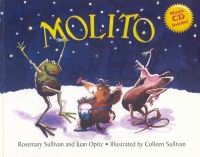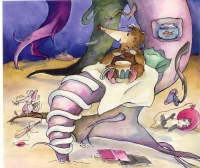| ________________
CM . . .
. Volume XVIII Number 13. . . .November 25, 2011 
 |
Molito.
Rosemary Sullivan & Juan Opitz. Illustrated by Colleen Sullivan.
Windsor, ON: Black Moss Press, 2011.
48 pp., includes CD, pbk., $18.00.
ISBN 978-0-88753-493-5.
Grades 1-5 / Ages 6-10.
Review by Meredith Cleversey.
**½ /4
|
| |
|

excerpt:
Deep under the ground lived a little mole named Molito. His fur was brown, the colour of burnt toast. His eyes were as yellow as the sun.
All day long Molito liked to burrow and tunnel. He made tunnels that went in circles and ones that went in squares. He made tunnels that led to the park. After a swing and a slide, he liked to sit down and play his drum.
Thrum! Thrum!
I'm Molito
I play my drum
In the earth so black
Come play with me
And I'll make you dance
In the underworld.
Molito is a little mole who is perfectly happy living in his underworld, digging tunnels and playing his drum. But after Carlota the ant tells him about the wonders of the upperworld, Molito sets out to explore this new, exciting place. It's a bit scary at first, but once Molito meets a little girl named Violeta, he realizes that even though they are different, he and Violeta share a love for music that can gap their two worlds.
The story of Molito, which is 48 pages long, is a little lengthy for a picture book. The idea behind this tale, that a creature from another culture can make friends and bridge the gap between societies, is nice, although at times this purpose seems a little forced. The story actually starts out seeming like an adventure book, with Molito exploring a new world to satisfy his curiosity. Then, it becomes all about the music, with an introduction to new instruments and lovely accompanying music on the audio CD. Right at the end of the story, however, it seems to switch gears again, and Molito's final song goes:
Above and below
In the dark and the light
Upside down and upside right
Below your feet and above your head
There's just one world.
There's just one world.
This song seems to suggest a realization that, even though Molito and his friends are different from the humans of the upperworld, everyone can get along and share. With so many pages to this book, it feels as though this story tried to take on too much, and the result is that the ideas are not fully realized in the text. There is nothing wrong with the way Molito's plot unfolds, but this story probably could have been simplified to only include one or two underlying themes which would have told essentially the same tale in a shorter space.
 The full-colour illustrations, done by Colleen Sullivan, are lively and fun. The images are bright and colourful, and they are full of movement. The illustrations are also wonderful in adding depth to certain passages in the book. When Molito is trying to imagine what the ant is telling him about the upperworld, the illustrations are humorous as they depict how this little mole imagines the world above him. When Violeta and her friends play instruments Molito has never seen before, the illustrations show the reader what these instruments actually look like, which is fantastic when coupled with the music CD that highlights the sound of each instrument as well.
The full-colour illustrations, done by Colleen Sullivan, are lively and fun. The images are bright and colourful, and they are full of movement. The illustrations are also wonderful in adding depth to certain passages in the book. When Molito is trying to imagine what the ant is telling him about the upperworld, the illustrations are humorous as they depict how this little mole imagines the world above him. When Violeta and her friends play instruments Molito has never seen before, the illustrations show the reader what these instruments actually look like, which is fantastic when coupled with the music CD that highlights the sound of each instrument as well.
Molito also comes with a CD which is actually an audio recording of the book. This recording, which is a little over fourteen minutes long, has some beautiful music composed by the Chilean Canadian musician Nano Valverde. The instruments introduced through this story (the pan flute, the charango, and the kena) are wonderfully showcased, and the music throughout gives mood and movement to the story, acting in great balance with the illustrations. Having these two components of the story work so well together makes Molito's journey really come alive for the reader.
The audio recording, itself, however, has some flaws. The flow of the narrative is not consistent. At some points, the narrator, author Rosemary Sullivan, takes long pauses between sentences, and, at other times, she takes too short of a pause; this is particularly an issue between pages as there are many instances in which there is no time for the reader to flip pages before the narrator starts speaking again. There is also one instance on page 31 where the text says "He nodded," but Sullivan says "Molito nodded," which can be confusing if a child is reading along with the recording.
Since there is music throughout the audio recording, it seems strange that Molito's songs are spoken on the CD and not sung and have little to no background accompaniment. Some of the sound effects as well are obviously stock sounds that feel out of place in the story. One such example of this is at the end of Molito's journey, when he digs a tunnel up from the underworld to the market. When the critters and the humans meet, the sound effect is of an end-of-show cheering, laughing, clapping crowd, which does not really match the story being told.
Molito is an interesting tale of how something simple like music can bring different cultures together. The illustrations of this book are colourful and fun, and they work well with the accompanying music to create a really unique story experience. However, the plot of this story is a bit drawn out, and the audio recording of this tale is choppy. This story provides an excellent introduction to musical instruments not usually seen in Canadian culture, and the end message of Molito, which is to understand that all types of individuals can get along even if they are different, is ultimately a great message to share.
Recommended.
Meredith Cleversey is a librarian who lives in Cambridge, ON. She loves to read, write, and live in a world of pure imagination.

To comment
on this title or this review, send mail to cm@umanitoba.ca.
Copyright © the Manitoba Library Association. Reproduction for personal
use is permitted only if this copyright notice is maintained. Any
other reproduction is prohibited without permission.
NEXT REVIEW |
TABLE OF CONTENTS FOR THIS ISSUE
- November 25, 2011.
AUTHORS |
TITLES |
MEDIA REVIEWS |
PROFILES |
BACK ISSUES |
SEARCH |
CMARCHIVE |
HOME |

 The full-colour illustrations, done by Colleen Sullivan, are lively and fun. The images are bright and colourful, and they are full of movement. The illustrations are also wonderful in adding depth to certain passages in the book. When Molito is trying to imagine what the ant is telling him about the upperworld, the illustrations are humorous as they depict how this little mole imagines the world above him. When Violeta and her friends play instruments Molito has never seen before, the illustrations show the reader what these instruments actually look like, which is fantastic when coupled with the music CD that highlights the sound of each instrument as well.
The full-colour illustrations, done by Colleen Sullivan, are lively and fun. The images are bright and colourful, and they are full of movement. The illustrations are also wonderful in adding depth to certain passages in the book. When Molito is trying to imagine what the ant is telling him about the upperworld, the illustrations are humorous as they depict how this little mole imagines the world above him. When Violeta and her friends play instruments Molito has never seen before, the illustrations show the reader what these instruments actually look like, which is fantastic when coupled with the music CD that highlights the sound of each instrument as well.